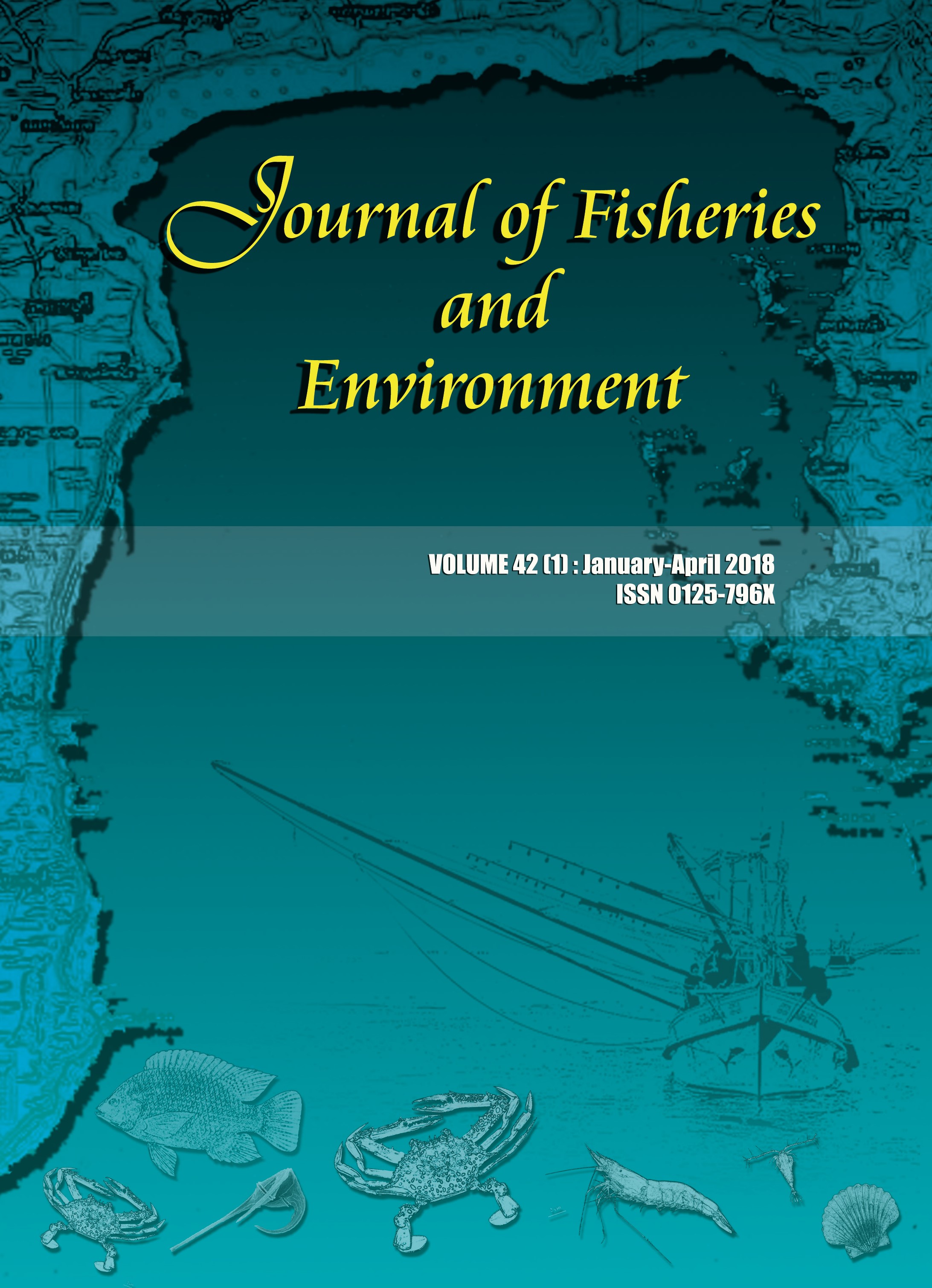Morphology and Anatomy of Corallimorpharian Metarhodactis aff. boninensis from Thailand
Main Article Content
Abstract
Corallimorpharians are sessile cnidarians that are widely distributed from tropical to the polar region. Corallimorpharians exhibit a high level of intraspecific morphological variation and this causes problems in identification and uncertainty of the species boundary. Metarhodactis is a monotypic genus of the family Discosomidae and widely distributed in Thai waters. However there were a few studies on the detailed morpho-anatomical structure of Metarhodactis species in Thailand. This study aimed to examine the morphological and anatomical characteristic of Metarhodactis aff. boninensis, and to confirm the taxonomic status of this species. Our specimens collected from Prachuap Khiri Khan Province, Thailand, exhibited an oval-shaped oral disc with curled edge and produced only unbranched papilliform tentacles. Zooxanthellae densely inhabit in the tentacle gastrodermal tissue. M. aff. boninensis bears only one nematocyst in which six cnidae types were found. Holotrichs III and microbasic p-mastigophores were the most abundant cnidae, followed by holotrichs I. Male and female reproductive organs were observed in separate individuals. It was obvious that the M. aff. boninensis in this study was clearly distinct from the original description of M. boninensis from Japan on the basis of tentacle shape, cnidae type, and its locality. We suggest that further study to clarify the taxonomic position of M. aff. boninensis is required considering a combined data of morpho-anatomical characteristics and molecular markers.
Article Details
References
2. Carlgren, O. 1943. East-Asiatic Corallimorpharia and Actiniaria. Kungliga Svenska Vetenskapsakademiens Handlingar 20 (6): 1–43
3. Cha, H. 2007. Systematics of the order Corallimorpharia (Cnidaria: Anthozoa). Ph.D. Thesis, University of Kansas. 217 p.
4. Chadwick, N. E., M. Spiegel, and I. Nir. 2000. Sexual reproduction in the tropical corallimorpharian Rhodactis rhodostoma. Invertebrate Biology 119 (4): 361–369.
5. Chen, C.A., C.P. Chen and I.M. Chen. 1995. Sexual and asexual reproduction of the tropical corallimorpharian Rhodactis (= Discosoma) indosinensis (Cnidaria: Corallimorpharia) in Taiwan. Zoological Studies 34 (1): 29–40.
6. Daly, M., M.R. Brugler, P. Cartwright, A.G. Collins, M.N. Dawson, D.G. Fautin, S.C. France, C. S. Mcfadden, D.M. Opresko, E. Rodriguez, S. Romano and J.L. Stake. 2007. The phylum Cnidaria: A review of phylogenetic patterns and diversity 300 years after Linnaeus. Zootaxa 1668: 127–182.
7. Fautin, D.G. 1992. Phylogenetic relationships among Scleractinians, Actiniarians, and Corallimorpharians (Coelenterata: Anthozoa). pp. 665–670. In Proceeding of the Seventh International Coral Reef Symposium. University of Guam Marine Laboratory. Guam.
8. Fautin, D.G. 2011. Corallimorphus niwa new species (Cnidaria: Anthozoa), New Zealand members of Corallimorphus, and redefinition of Corallimorphidae and its members. Zootaxa 2775: 37–49.
9. Fautin, D.G., J.M. Guinotte and J.C. Orr. 2009. Comparative depth distribution of corallimorpharian and scleractinians (Cnidaria: Anthozoa). Marine Ecology Progress Series 397: 63–70.
10. Fautin, D.G. and R.M. Mariscal. 1991. Cnidaria: Anthozoa, pp. 267–358. In F.W. Harrison and J. A. Westfall, eds. Microscopic Anatomy of Invertebrates. New York.
11. Fautin D.G., T.Zelenchuk and D.R. Veendran. 2007. Genera of orders Actiniaria and Corallimorpharia (Cnidaria, Anthozoa, Hexacorallia), and their type species. Zootaxa 1668: 183–244.
12. Holts, L.A. and K.A. Beauchamp. 1993. Sexual reproduction in the corallimorpharian sea anemone Corynactis californica in a central California kelp forest. Marine Biology 116 (1): 129–136.
13. Honma, K., H. Udono, T. Kohno, K. Yamamoto, A. Ogawa, T. Takemori, A. Kumatori , S. Suzuki, T. Matsuyama and K. Yui. 2005. Interferon regulatory factor 4 negatively regulates the production of proinflammatory cytokines by macrophages in response to LPS. Proceedings of the National Academy of Sciences of the United States of America. 102 (44): 16001–16006.
14. Lang, J.C. and E.A. Chornesky. 1990. Competition between scleractinian reef corals -a review of mechanisms and effects, pp 209–252. In D. Dubinsky, eds. Ecosystems of the world. Elsevier, Amsterdam.
15. Langmead, N. and N. Chadwick-Furman, 1999. Marginal tentacles of the corallimorpharian Rhodactis rhodostoma. 1. Role in competition for space. Marine Biology 134: 479–489.
16. Luna, L.G. 1968. Manual of histologic staining methods of the armed forces institute of pathology, 3rd ed. Mc Graw Hill, New York, 258 p.
17. Miles, J. 1991. Inducible agonistic structures in the tropical Corallimorpharian,
Discosoma sanctithomae. The Biological Bulletin 180: 406–415.
18. Nilkerd, B., A. Swatdipong, J. Salaenoi and S. Tunkijjanukij. 2015. Pilot survey of Corallimorpharian (Cnidaria) diversity in the gulf of Thailand. Kasetsart University Fisheries Research Bulletin 39 (2): 31–46.
19. Östman, C. 1991. Scanning electron microscopic observations on Scandinavian scyphozoans with special references to their nematocysts. pp. 283–292. In Proceedings of the II Workshop on Jellyfish in the Mediterranean Sea, Map Technical Rep. UNEP. Athens.
20. Östman, C. 2000. A guideline to nematocyst nomenclature and classification, and some notes on the systematic value of nematocysts. Scientia Marina 64 (1): 31–46.
21. Watson, G.M. and R.L. Wood. 1988. Colloquium on Terminology, pp. 21–23. In D.A. Hessinger and H.M. Lenhoff, eds. The Biology of Nematocysts. Academic Press, San Diego.
22. Williams, R.B. 1991. Acrorhagi, catch tentacles and sweeper tentacles: a synopsis of ‘aggression’ of actiniarian and scleractinian Cnidaria. Hydrobiology 216(1): 539–545.


